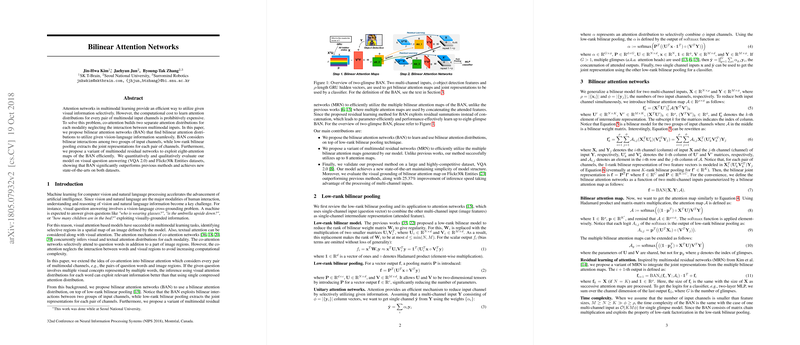An Expert Overview of Bilinear Attention Networks
The paper "Bilinear Attention Networks" presents a novel approach to enhancing multimodal learning, especially in tasks involving vision-language interactions, such as Visual Question Answering (VQA) and visual grounding with datasets such as Flickr30k Entities. The authors propose the Bilinear Attention Networks (BAN) model, which fundamentally seeks to improve the way attention mechanisms handle multimodal input channels by leveraging bilinear interactions.
Key Contributions
The paper introduces three significant contributions to the domain of multimodal learning:
- The development of Bilinear Attention Networks (BAN) that utilize bilinear attention distributions on top of a low-rank bilinear pooling technique.
- A variant of multimodal residual networks (MRN) to efficiently utilize multiple bilinear attention maps generated by the BAN, with a specific focus on parameter efficiency and performance.
- An extensive evaluation of their model on the VQA 2.0 and Flickr30k Entities datasets, demonstrating improved performance and efficiency.
Bilinear Attention Networks (BAN)
The BAN model addresses critical shortcomings in co-attention networks, which often neglect interactions between multimodal inputs due to increased computational complexity. BAN overcomes this by introducing bilinear interactions between two groups of input channels (e.g., pairs of question words and image regions). This method employs low-rank bilinear pooling to extract joint representations for each pair of input channels, thereby preserving and exploiting rich multimodal information.
Low-Rank Bilinear Pooling
The authors build upon previous work on low-rank bilinear models to reduce computational overhead while maintaining performance. They describe a method where a high-dimensional bilinear weight matrix is decomposed into two smaller matrices, ensuring that the rank is significantly reduced without losing essential information. This approach allows the model to compute efficient attention maps that selectively combine the visual and textual information.
Multimodal Residual Networks (MRN) Variant
The paper innovatively extends MRN to integrate bilinear attention maps robustly. Unlike previous mechanisms that concatenate attended features, the proposed residual learning method utilizes residual summations. This variant significantly enhances model performance while maintaining parameter efficiency, enabling the effective use of multiple bilinear attention maps (up to eight-glimpse BAN).
Experimental Results
The experimental validation on the VQA 2.0 dataset showcases the superiority of BAN over prior methods. The model achieves new state-of-the-art results, with specific improvements noted in the handling of vision-language tasks. For instance, BAN reaches a performance of 69.52% on the VQA 2.0 test-standard split, significantly outperforming baseline models.
Further, the application of BAN on the Flickr30k Entities dataset demonstrates its effectiveness in visual grounding tasks. The model achieves a Recall@1 score of 69.69%, outperforming several state-of-the-art methods and highlighting its capability to handle fine-grained vision-language tasks effectively.
Implications and Future Directions
The advancements presented in BAN have several practical and theoretical implications:
- Practical Implications: The ability of BAN to efficiently handle interactions between visual and textual modalities opens new avenues for applications such as autonomous systems, robotic vision, and intelligent assistants that rely heavily on understanding complex multimodal inputs.
- Theoretical Implications: From a theoretical standpoint, the residual learning of attention maps and the efficient computation of bilinear interactions push the boundaries of current multimodal learning paradigms. This approach could inspire further research into other types of attention mechanisms and poolings that can leverage low-rank approximations for richer representations.
Looking forward, future developments in this area could include exploring different bilinear pooling techniques, improving the interpretability of attention maps, and extending these mechanisms to other domains such as audio-visual learning and cross-modal retrieval systems.
In conclusion, while the BAN model introduces sophisticated mechanisms for handling multimodal data efficiently, the simplicity in model design and significant performance improvements highlight its potential for future research and practical applications in artificial intelligence.
